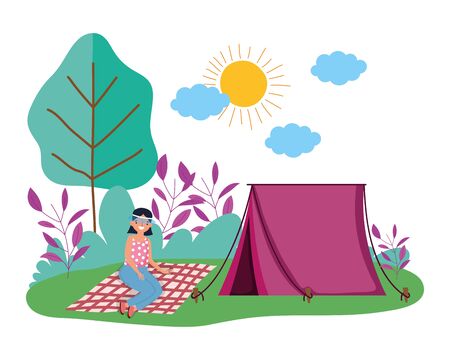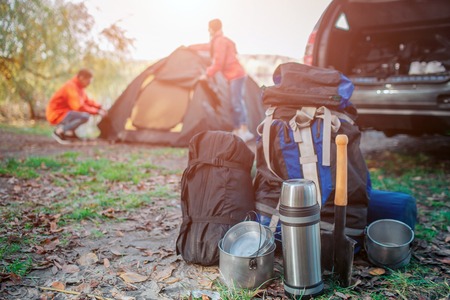1. Pre-Trip Planning Essentials
Before you pack your bags or dust off your tent, the first step for any first-time camper is thorough pre-trip planning. Start by deciding what kind of camping experience you want—whether it’s a family-friendly campground with amenities, a backcountry adventure, or something in between. Once you’ve picked your vibe, research campgrounds in your desired location and check their availability. Popular sites can book up months in advance, so don’t wait until the last minute to make your reservation.
Understanding campground rules is just as important as securing your spot. Each site may have specific regulations about fires, pets, noise, and quiet hours, so review these details ahead of time to avoid any surprises. Also, take a close look at the amenities offered—are there bathrooms, showers, picnic tables, or fire rings? Knowing what to expect helps you pack smarter.
Finally, always check the weather forecast for your destination during the dates you’ll be there. Weather can make or break a camping trip, especially if you’re unprepared for rain or unexpected temperature drops. It’s also smart to familiarize yourself with the area’s local wildlife and terrain so you know what gear and precautions to bring along. With solid research and careful planning, you’ll set yourself up for an unforgettable—and stress-free—camping experience.
2. Must-Have Camping Gear
Getting your gear right can make or break your first camping experience. Whether you’re pitching a tent in a national park or setting up at a local campground, having the right essentials ensures comfort, safety, and a whole lot more fun. Here’s a quick breakdown of must-have items for first-time campers:
Essential Camping Equipment
| Item | Purpose |
|---|---|
| Tent | Shelter from weather and insects; choose one that fits your group size and is easy to set up |
| Sleeping Bag | Insulation and comfort for sleeping; pick one rated for the lowest temperature you expect |
| Sleeping Pad or Air Mattress | Adds cushion and insulation from the cold ground |
| Lighting (Lanterns, Flashlights, Headlamps) | Illuminates your campsite after dark; headlamps are great for hands-free tasks |
| Cooking Supplies (Stove, Fuel, Cookware) | Makes meal prep possible; don’t forget matches or a lighter! |
Helpful Extras You’ll Be Glad You Packed
- Bug Spray – Keeps mosquitoes and other pests away, especially in summer months.
- Camp Chairs – Offers comfort around the fire or while relaxing at your site.
- Cooler – Keeps food and drinks cold, essential for longer stays.
- First Aid Kit – Be ready for minor scrapes, cuts, or headaches.
Packing Tips for Beginners
- Make a checklist ahead of time so nothing gets left behind.
- Test all gear at home—set up your tent and check your flashlight batteries before you go.
The Bottom Line
Your gear doesn’t have to be fancy or expensive, but it should be reliable. Focus on staying dry, warm, and well-fed. Once you’ve got these basics down, you’re well on your way to enjoying everything America’s great outdoors has to offer.

3. Packing Smart: Clothing & Personal Items
When it comes to camping for the first time, packing smart can make or break your experience. The weather in most U.S. campgrounds can change quickly, so choosing the right clothing is crucial. Layering is key: pack moisture-wicking base layers, an insulating mid-layer like a fleece or lightweight down jacket, and a waterproof outer shell for unexpected rain or wind. Don’t forget extra socks and underwear—nobody likes putting on damp clothes in the morning!
For personal hygiene, stick to the basics but don’t overlook essentials. Bring biodegradable soap, a toothbrush and toothpaste, deodorant, wet wipes (life-savers when showers are scarce), and hand sanitizer. A quick-dry towel will come in handy at campgrounds with limited amenities. And yes, toilet paper is always a good idea—some sites run out fast!
Your first aid kit should be well-stocked but not overwhelming. Include adhesive bandages, antiseptic wipes, tweezers (for splinters or ticks), pain relievers, allergy meds, and any prescription medications you require. Bug spray and sunscreen are absolute musts for protection against insects and harsh UV rays.
Remember, packing light doesn’t mean skimping on comfort or safety. With these tips, you’ll be ready for whatever nature—and the campsite—throws your way.
4. Setting Up Camp Like a Pro
Step-by-Step Guide to Pitching Your Tent
Setting up your campsite is more than just finding a flat patch of ground. Follow these steps to ensure your temporary home is safe, comfortable, and ready for adventure:
- Pick the Right Spot: Look for level ground away from water sources, overhanging branches, and animal trails. Avoid low spots where water can pool if it rains.
- Clear the Area: Remove rocks, sticks, and debris that could damage your tent or make sleeping uncomfortable.
- Lay Down a Ground Tarp: Place a waterproof tarp under your tent to prevent moisture from seeping in.
- Pitch Your Tent: Follow the manufacturer’s instructions. Stake down corners securely and use guy lines for stability, especially in windy conditions.
Arranging Your Campsite Safely
| Campsite Element | Recommended Distance/Placement |
|---|---|
| Tent | At least 200 feet from water sources; upwind from campfire |
| Campfire | 15 feet away from tents and gear; clear area of dry brush/leaves |
| Cooking Area | Downwind and at least 50 feet from sleeping area |
| Food Storage | Use bear-proof containers; store 100 feet from tent if possible |
Making Your Campsite Cozy & Secure
- Add a welcome mat or small rug outside your tent to keep dirt out.
- String up battery-powered lights or lanterns for safe nighttime navigation.
- Bring camp chairs or inflatable pads for comfy seating around the fire.
- Keep valuables in a secure spot (locked car or hidden bag).
Pro Tip:
Always check local guidelines about fire safety and wildlife precautions before setting up camp. A little prep goes a long way toward a fun and stress-free camping experience!
5. Outdoor Cooking & Food Safety
Guidelines for Meal Planning
When it comes to camping, planning your meals ahead of time is key. Opt for easy-to-cook recipes that require minimal ingredients and equipment. Think sandwiches, pre-made salads, or foil packet dinners you can cook over the fire. Make a checklist of all ingredients and necessary cookware so nothing gets left behind. Don’t forget to plan for snacks and plenty of water—hydration is crucial, especially when you’re active outdoors.
Storing Food to Avoid Wildlife Encounters
One of the most important rules in American campgrounds is to keep wildlife at bay by properly storing your food. Use bear-proof containers if available, or store all food and scented items (including toiletries) in your car or designated storage lockers. Never leave food out unattended—even small critters like raccoons can cause big problems. Remember: “A fed bear is a dead bear,” so always follow local guidelines to protect both yourself and the animals.
Easy Campground Recipes
Classic S’mores
No camping trip is complete without s’mores! All you need are graham crackers, chocolate bars, and marshmallows. Roast marshmallows over the campfire, sandwich with chocolate between two graham crackers, and enjoy this American camping classic.
Foil Packet Dinners
Layer sliced potatoes, veggies, and your choice of protein (like chicken or ground beef) on a sheet of heavy-duty foil. Season, fold up tightly, and cook over hot coals for about 30 minutes.
Breakfast Burritos
Pre-make breakfast burritos at home with eggs, cheese, and cooked sausage or bacon. Wrap in foil and heat them up on the campfire grill for an easy morning meal.
Responsible Cleanup Tips
Always clean up immediately after cooking and eating. Wash dishes at least 200 feet away from lakes or streams using biodegradable soap. Pack out all trash—including food scraps—to help keep campsites pristine for future campers. Leave no trace is the golden rule: If you pack it in, pack it out!
6. Staying Safe and Following Campground Etiquette
Camping for the first time is exciting, but it’s important to keep safety and respect in mind to ensure a smooth experience for everyone. Here are essential tips and unwritten rules every new camper should know:
Safety First: Protect Yourself and Others
- Know Your Surroundings: Upon arrival, familiarize yourself with the campground map, emergency exits, and the location of ranger stations or park staff.
- Wildlife Awareness: Store food securely in bear-proof containers or your vehicle if required. Never feed wild animals—it’s unsafe for both you and them.
- Campfire Safety: Only build fires in designated fire rings. Always have water nearby to extinguish flames completely before leaving or going to sleep. Follow all local fire regulations.
- First Aid Preparedness: Keep a stocked first aid kit handy and know basic first aid skills. Familiarize yourself with symptoms of heat exhaustion, dehydration, and insect bites common in the area.
- Buddy System: Don’t wander off alone, especially at night. Let someone know where you’re going whenever you leave the campsite.
Key Campground Etiquette: Be a Good Neighbor
- Respect Quiet Hours: Most campgrounds enforce quiet hours, typically between 10 p.m. and 6 a.m. Keep voices down and avoid loud music to help everyone rest well.
- Leave No Trace: Pack out all trash, leftover food, and gear. Leave your campsite cleaner than you found it.
- Share Facilities: Be considerate when using shared bathrooms, showers, and picnic tables. Clean up after yourself so others can enjoy them too.
- Control Pets: Keep pets on leashes at all times and clean up after them. Not everyone is comfortable around animals.
- Avoid Cutting Through Campsites: Respect other campers’ space by sticking to marked paths instead of taking shortcuts through occupied sites.
Your Responsibility as a Camper
Campsites thrive on community respect and personal responsibility. By following these safety tips and etiquette rules, you’ll not only protect yourself but also help create a welcoming environment for fellow adventurers. Happy camping!

